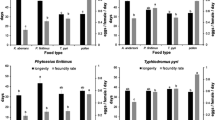Abstract
The endeostigmatid mitesAlicorhagia fragilis andAlycus spp. are nematophages. Nematodes are cut up by the chelicerae or ingested whole, but are difficult to recognize as gut contents.Alycus roseus is a strict predator and does not consume microphytes.Alicorhagia fragilis is an omnivore. When nematodes are not available, adult females consume more fungi, but lay significantly fewer eggs, and cultures eventually decline to extinction.
Observations of gut contents from 18 genera in ten families indicate that species in the families Terpnacaridae, Grandjeanicidae, Lordalycidae, Micropsammidae, and Oehserchestidae are primarily particulate-feeding fungivores. The families Namorchestidae and Nematalychidae are apparently fluid feeders. Species of Alicorhagiidae are best considered omnivores. In the family Bimichaelidae (=Pachygnathidae)_species with chelate-dentate chelicerae (Alycus, Petralycus, somePachygnathus) are predators of soft-bodied microinvertebrates. Species with attenuate, highly modified chelicerae (e.g.Bimichaelia) have unknown feeding habits.
Alicorhagia fragilis spins a silken thread from its oral cavity with which immatures weave a molting cocoon and with which females weave a platform on which their eggs are laid.
Similar content being viewed by others
References
Abbatiello, M.J., 1965. A culture chamber for rearing soil mites. Turtox News, 43: 162–163.
Gressitt, J.L. and Shoup, J., 1967. Ecological notes on free-living mites in North Victoria land. In: J.L. Gressitt (Editor), Entomology of Antarctica. Am. Geophys. Union Publ. No. 1574, pp. 307–320.
Herzberg, M.A., Klein, D.A. and Coleman, D.C., 1978. Trophic interactions in soils as they affect energy and nutrient dynamics. II. Physiological responses of selected rhizosphere bacteria. Microb. Ecol., 4: 351–359.
Kethley, J., 1982. Acariformes—Prostigmata. In: S.P. Parker (Editor), Synopsis and Classification of Living Organisms. McGraw-Hill, New York. Vol. 2, pp. 117–144.
Krantz, G.W., 1978. A Manual of Acarology. Second Edition. Oregon State Univ. Book Stores, Inc., Corvallis, 509 pp.
Norton, R.A., 1985. Aspects of the biology and systematics of soil arachnids particularly saprophagous and mycophagous mites. Quaest. Entomol., 21: 523–541.
Schuster, R., 1979. Soil mites in the marine environment. In: J.G. Rodriguez (Editor), Recent Advances in Acarology, Vol. 1. Academic Press, New York, pp. 593–602.
Schuster, R. and Schuster, I.J., 1977. Ernährungs- und fortpflanzungsbiologische Studien and der Milbenfamilie Nanorchestidae (Acari, Trombidiformes). Zool. Anz., Jena, 199: 89–94.
Theron, P.D., 1976. New species of the genusTerpnacarus Grandjean (Acari: Terpnacaridae) with notes on the biology of one species. J. Entomol. Soc. South. Afr., 39: 131–141.
Theron, P.D., 1979. The functional morphology of the gnathosoma of some liquid and solid feeders in the Trombidiformes, Cryptostigmata and Astigmata (Acarina). In: E. Piffl (Editor). Proc. 4th Int. Congress of Acarology. Akadémiai Kiadó, Budapest, pp. 575–579.
Author information
Authors and Affiliations
Rights and permissions
About this article
Cite this article
Walter, D.E. Predation and mycophagy by endeostigmatid mites (Acariformes: Prostigmata). Exp Appl Acarol 4, 159–166 (1988). https://doi.org/10.1007/BF01193873
Accepted:
Issue Date:
DOI: https://doi.org/10.1007/BF01193873




